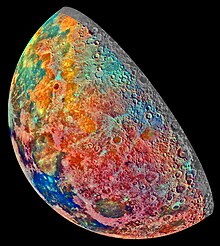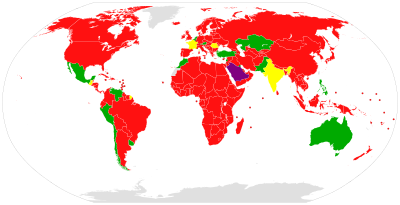
The United Nations Convention on the Law of the Sea (UNCLOS), also called the Law of the Sea Convention or the Law of the Sea Treaty, is an international agreement that establishes a legal framework for all marine and maritime activities. As of May 2023, 168 countries and the European Union are parties.

The Outer Space Treaty, formally the Treaty on Principles Governing the Activities of States in the Exploration and Use of Outer Space, including the Moon and Other Celestial Bodies, is a multilateral treaty that forms the basis of international space law. Negotiated and drafted under the auspices of the United Nations, it was opened for signature in the United States, the United Kingdom, and the Soviet Union on 27 January 1967, entering into force on 10 October 1967. As of March 2024, 115 countries are parties to the treaty—including all major spacefaring nations—and another 22 are signatories.

Space law is the body of law governing space-related activities, encompassing both international and domestic agreements, rules, and principles. Parameters of space law include space exploration, liability for damage, weapons use, rescue efforts, environmental preservation, information sharing, new technologies, and ethics. Other fields of law, such as administrative law, intellectual property law, arms control law, insurance law, environmental law, criminal law, and commercial law, are also integrated within space law.

Colonization of the Moon is a process or concept employed by some proposals for robotic or human exploitation and settlement endeavours on the Moon. Settling of the Moon is, therefore, a more specific concept of lunar habitation, for which the broader concept of colonization is often used as a synonym, a use that is contested in the light of colonialism.

Asteroid mining is the hypothetical extraction of materials from asteroids and other minor planets, including near-Earth objects.

Extraterrestrial real estate refers to claims of land ownership on other planets, natural satellites, or parts of space by certain organizations or individuals. Previous claims are not recognized by any authority, and have no legal standing. Nevertheless, some private individuals and organizations have claimed ownership of celestial bodies, such as the Moon, and are actively involved in "selling" parts of them through certificates of ownership termed "Lunar deeds", "Martian deeds" or similar.

The United Nations Committee on the Peaceful Uses of Outer Space (COPUOS) is a United Nations committee whose main task is to review and foster international cooperation in the peaceful uses of outer space, as well as to consider legal issues arising from the exploration of outer space.
Lunar treaty may refer to:
Space jurisdiction, a field addressing what countries can enforce various laws in space, has become more important as the private sector enters the field of space tourism. Under the Outer Space Treaty of 1967, while space and celestial bodies cannot be appropriated by nations, objects launched into space and personnel on board them remain under the jurisdiction of the state of registry.
Space-based economy is economic activity in outer space, including asteroid mining, space manufacturing, space trade, construction performed in space such as the building of space stations, space burial, and space advertising.
Space policy is the political decision-making process for, and application of, public policy of a state regarding spaceflight and uses of outer space, both for civilian and military purposes. International treaties, such as the 1967 Outer Space Treaty, attempt to maximize the peaceful uses of space and restrict the militarization of space.

The politics of outer space includes space treaties, law in space, international cooperation and conflict in space exploration, international economics, and the hypothetical political impact of any contact with extraterrestrial intelligence.

Common heritage of humanity is a principle of international law that holds the defined territorial areas and elements of humanity's common heritage should be held in trust for future generations and be protected from exploitation by individual nation states or corporations.

The space policy of the United States includes both the making of space policy through the legislative process, and the implementation of that policy in the United States' civilian and military space programs through regulatory agencies. The early history of United States space policy is linked to the US–Soviet Space Race of the 1960s, which gave way to the Space Shuttle program. At the moment, the US space policy is aimed at the exploration of the Moon and the subsequent colonization of Mars.
In international law, a depositary is a government or organization to which a multilateral treaty is entrusted. The principal functions of a depositary are codified in Article 77 of the Vienna Convention on the Law of Treaties.

The Commercial Space Launch Competitiveness Act, sometimes referred to as the Spurring Private Aerospace Competitiveness and Entrepreneurship (SPACE) Act of 2015, is an update of the United States Government of its commercial space use, legislated in 2015. The update to US law explicitly allows US citizens and industries to "engage in the commercial exploration and exploitation of space resources" including water and minerals. The right does not extend to extraterrestrial life, so anything that is alive may not be exploited commercially.

Asgardia, also known as the Space Kingdom of Asgardia and Asgardia the Space Nation, is a micronation formed by a group of people who have launched a satellite into Earth orbit. They refer to themselves as "Asgardians" and they have given their satellite the name "Asgardia-1". They have declared sovereignty over the space occupied by and contained within Asgardia -1. The Asgardians have adopted a constitution and they intend to access outer space free of the control of existing nations and establish a permanent settlement on the Moon by 2043.

The Moon bears substantial natural resources which could be exploited in the future. Potential lunar resources may encompass processable materials such as volatiles and minerals, along with geologic structures such as lava tubes that, together, might enable lunar habitation. The use of resources on the Moon may provide a means of reducing the cost and risk of lunar exploration and beyond.

The Artemis Accords is a series of non-binding bilateral arrangements between the United States government and other world governments that elaborates on the norms expected to be followed in outer space. The accords are related to the Artemis program, an American-led effort to return humans to the Moon by 2026, with the ultimate goal of expanding space exploration to Mars and beyond. As of April 19, 2024, thirty-nine countries have signed the accords, including nineteen in Europe, eight in Asia, five in South America, three in North America, three in Africa and two in Oceania.

Space sustainability aims to maintain the safety and health of the space environment.
















